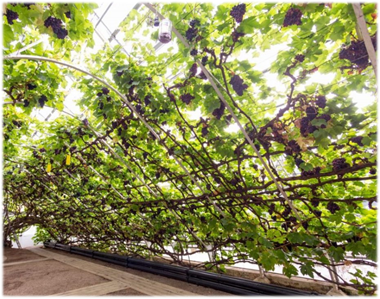The largest Grape Vine in the World
The Great Vine, Vitis vinifera ‘Schiava Grossa’ (synonym: Black Hamburg), is now 250 years old and is the largest grape vine in the world. It was planted in 1768 while Lancelot ‘Capability’ Brown was in charge of the gardens at Hampton Court.Lancelot ‘Capability’ Brown directed the planting of the Great Vine from a cutting taken at Valentines Mansion in Essex. In 1887 it was already 1.2 metres (4′) around the base. It is now four metres (13′) around the base and the longest rod is 36.5 metres (120′). The Vine is grown on the extension method where one plant fills a glasshouse, as Victorian gardeners thought this method would produce a larger crop. The average crop of black dessert grapes is about 272 kilograms (600lbs), however in the autumn of 2001 it was 383 kilograms (845 lbs) – the best crop ever. The grapes are ripe after August Bank Holiday and are sold during the first three weeks of September in the palace shop. Queen Victoria had grapes from the Great Vine sent to the Royal Household at Windsor or to Osbourne House on the Isle of Wight. The decision to allow them to be sold to visitors was made by Edward VII, who decided the Royal Household no longer needed them. Later they were sold in small wicker baskets at St. Dunstans, the home for soldiers blinded in the First World War. in the Second World War German P-O-Ws were given the task of thinning out the bunches of grapes. The Vine grows on the site of the first greenhouse at Hampton Court. There have been five or six glasshouses on the site throughout its history. n the early 1900s a three-quarter span wooden glasshouse was built which was a new shape and quite different from what existed before, as this one incorporated a viewing area for the public. In 1969 a new glasshouse was needed. By that time, the Vine had become so entwined in the existing structure the only way forward was to build a new aluminium glasshouse over the old wooden one. The dormant vine was protected by polythene sheeting and the old glass and its supporting wooden frame was removed, leaving the iron framework of the 20th-century structure and the Vine in place.

